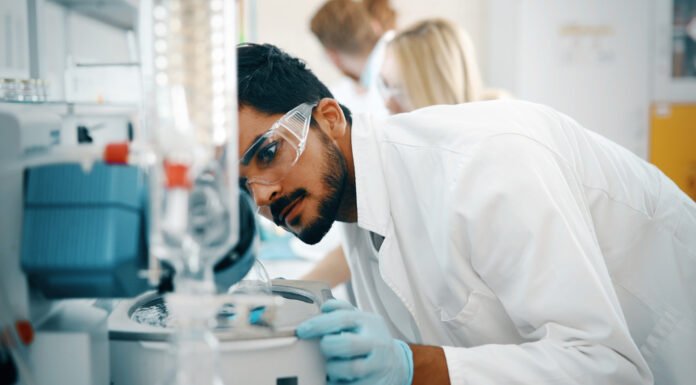Having your private lab isn’t as far-fetched as it might seem.
In many cases, growing companies outsource this necessity to specialty labs, but as your company grows, it might be time to set up your lab. Of course, this requires you to learn what you need and don’t need at a certain level of depth.
When it comes to the types of laboratory equipment you’ll need to invest in, the sheer volume of items can be daunting. In this article, we’ll give you a wide-ranging introduction to popular pieces of lab equipment.
Erlenmeyer Flask
An Erlenmeyer Flask is an iconic piece of laboratory equipment. It is commonly used to mix, heat, and store chemicals and other substances. The flask has a wide, flat bottom and narrow neck, shaped like an inverted cone.
This makes it easy to hold and provides a larger bottom surface to ensure better heat and heat distribution. This flask also has standardized measurements on the side of the flask, making it a convenient tool to measure precise quantities. It is commonly used for titration experiments and another laboratory testing.
It’s an important piece of laboratory equipment for any scientific experiment. The Erlenmeyer Flask has the most standard uses of any laboratory flask, making it perfect for experimenting, researching, and more.
Beaker
A beaker is a type of laboratory equipment that is typically used to store, mix, and heat liquids. Beakers come in a variety of sizes and shapes, ranging from cups and small mugs to wide-mouth, two-liter jugs.
Beakers are typically made of either glass or reusable plastic, depending on the intended application. When using a beaker for mixing or heating liquids, it is essential to follow laboratory safety protocols and wear the proper protective gear.
A beaker should never be moved without using protective gloves. It is also important to note that beakers are not water-tight and should not be used to transport liquid samples.
Beakers should be clearly labeled to indicate what liquids they contain. Finally, beakers should be washed and thoroughly dried after each use.
Test Tube
A test tube is a type of laboratory equipment used to mix and heat liquids. Initially made of glass, newer models are now made from biocompatible PEEK (Polyether Ether Ketone) tubing. Test tubes are cylindrical in shape, with a flat or rounded end, and can be up to 30cm in length.
Test tube users should always wear safety glasses, lab coat and gloves when handling chemicals and other specimens in the laboratory. Test tube uses can range from holding samples for heating or cooling applications to swirling and mixing specimen solutions.
If a clear view is necessary for observation, then a test tube made of transparent PEEK tubing provides this. When using a PEEK test tube, it is important to note that PVC tools should never be used as these can cause scratching.
Also, since these tubes come in different sizes, be sure to use the correct test tube size for the needed applications. If you are unsure of how peek PEEK tubes work, you may check out what is peek tubing here.
Vial With Cap
A vial with a cap is a common laboratory apparatus that is used in a variety of scientific applications. It is typically a glass or plastic container with a sealed lid or cap that prevents the contents inside from contamination. The vial can be used to store volatile and or liquid chemicals for later use and to collect a sample of blood, urine, or other bodily fluids for analysis.
It is also used to transport a specific amount of medication or chemical from one place to another. Vials with caps can variously be made from glass, plastic, aluminum, or steel depending on the intended purpose. The material choice for a vial and corresponding cap determines the type of substances it can hold and the necessary chemical compatibility to ensure safe storage and transport of the material.
Glassware for Measurements
Glassware for Measurements is one of the important types of laboratory equipment that is used to measure liquid and powder substances. It is typically composed of glass or plastic and comes in various shapes and sizes. This is to suit the needs of the lab.
Common types of glassware include volumetric flasks, pipettes, burettes, graduated cylinders, volumetric cylinders, and measuring cylinders. These types of glassware provide starting points for precise measurements. This can be used for educational, scientific, and/or medical purposes.
Depending on the task at hand, glassware can vary in volume capacity, precision, and accuracy. Knowing which type of glassware is most suitable for the measurement and the purpose of the use is essential to get accurate results and avoid any potential hazards or accidents.
Microscope
The microscope is one of the most essential lab equipment. It is used to magnify and observe microorganisms, cells, and other samples. The microscope consists of a base, body, and head with an eyepiece and objective lens.
The microscope is used to magnify cells, assess microorganisms and carry out histology experiments and pathology screening. This also includes examining cells for structure and motility and observing living organisms. Many pieces of equipment are designed for use with the microscope.
These are such as manual or automated slide makers, sample incubators, and imaging systems. It is important to follow proper safety protocols and maintain laboratory equipment. This is to get accurate results in your experiments.
Choose the Right Laboratory Equipment for Your Project
Laboratory equipment is essential for successfully performing experiments and research. It is important to understand the different types of laboratory equipment, what they are used for, and how to properly use them.
Doing so will ensure that data is collected accurately and efficiently. Research and carefully select the right laboratory equipment for your needs today. This is to ensure success in your experiments tomorrow.
If you want to read more articles, visit our blog.













